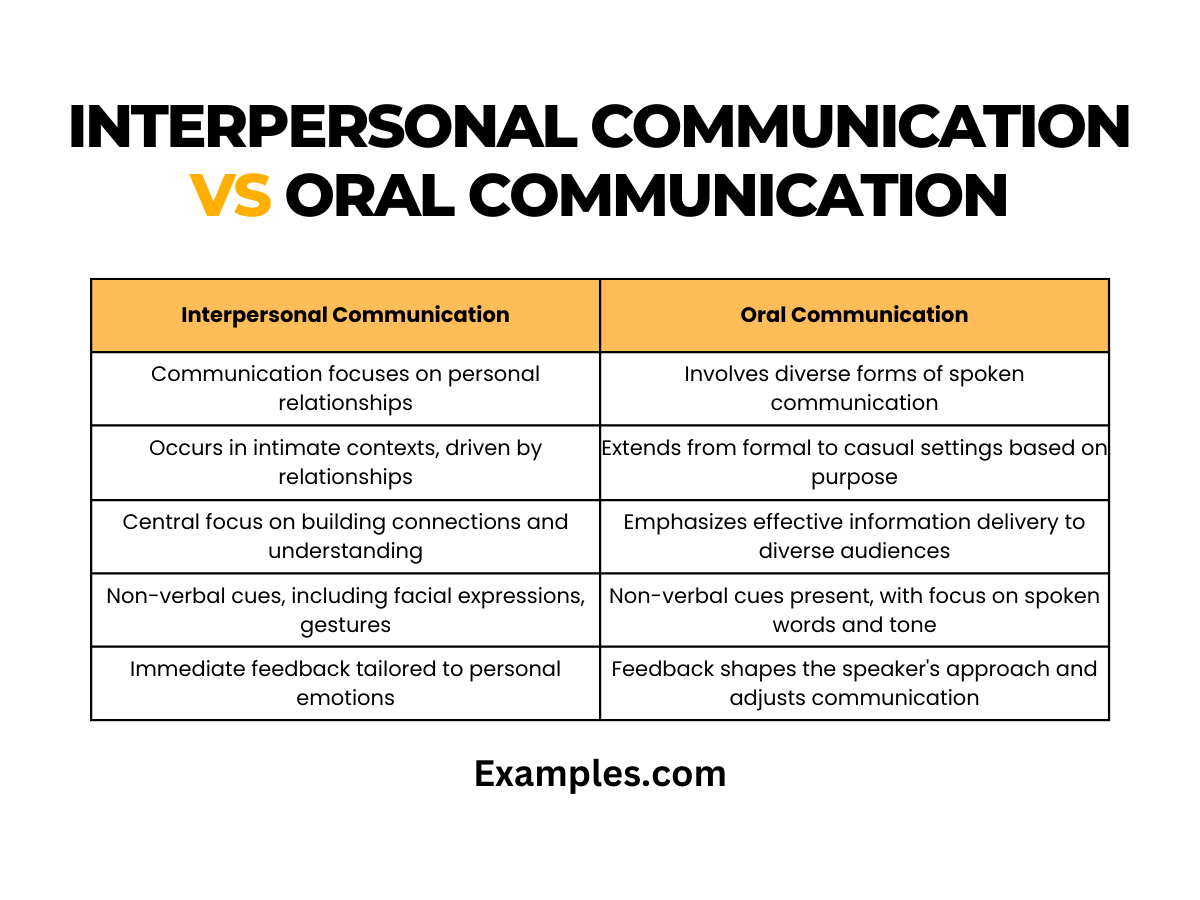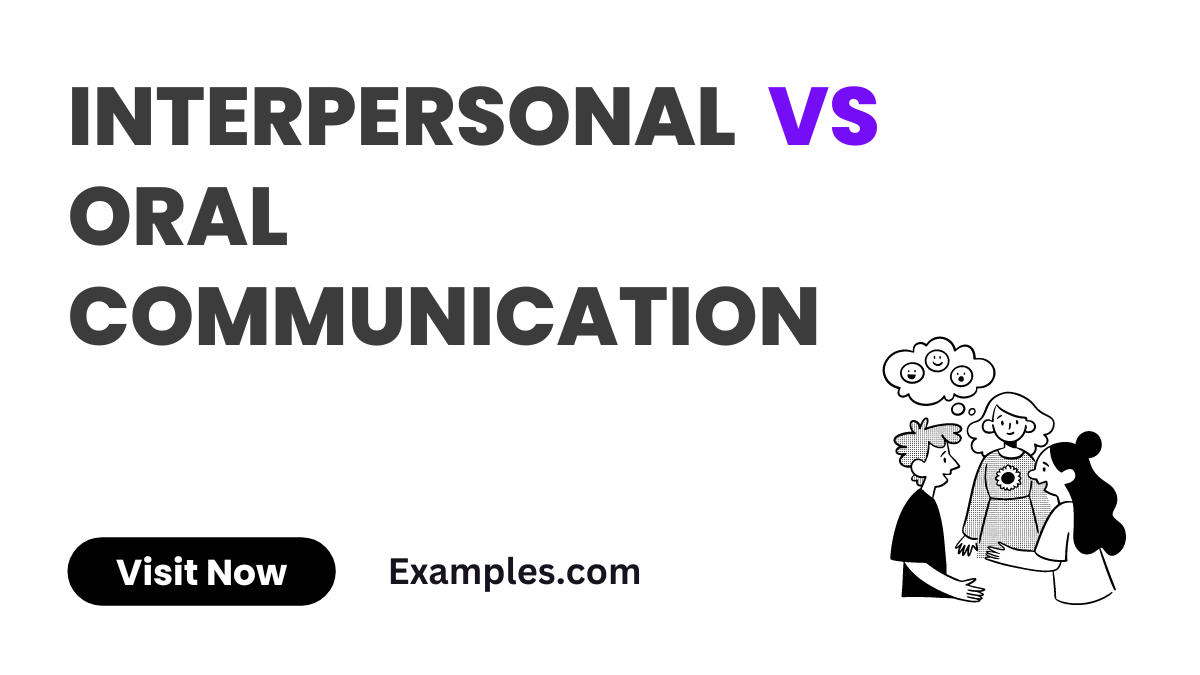Interpersonal Communication vs Oral Communication – 19+ Examples
Embark on a comprehensive exploration of communication dynamics with our guide on Interpersonal Communication vs Oral Communication. Unravel the nuances between personal interactions and verbal expressions, delving into real-world scenarios and illuminating instances in the realm of “Communication Examples.” From intimate conversations to formal speeches, grasp the distinctive features that shape effective communication through direct verbal exchanges in diverse contexts. Enhance your understanding of the intricacies between one-on-one dialogues and broader oral communication frameworks.
Difference between Interpersonal Communication and Oral Communication?

Embark on a nuanced exploration of communication dynamics as we dissect the differences between Interpersonal and Oral Communication. Delve into the details through an insightful table:
| Criteria | Interpersonal Communication | Oral Communication |
|---|---|---|
| Participants | Involves communication between individuals, focusing on personal relationships. | Broadly encompasses any communication through spoken words, including presentations, speeches, and discussions. |
| Context and Setting | Primarily occurs within a more intimate, personalized context, driven by individual relationships. | Extends to diverse settings, from formal speeches and presentations to casual conversations, depending on the purpose. |
| Focus of Interaction | Centrally focused on building personal connections, understanding, and nurturing relationships. | Emphasizes conveying information, ideas, or messages effectively, catering to diverse audience needs. |
| Non-Verbal Cues | Non-verbal cues play a significant role, including facial expressions, gestures, and body language. | While non-verbal cues are still present, the emphasis is often on spoken words and vocal elements like tone, pitch, and pace. |
| Feedback Dynamics | Immediate feedback is direct and tailored to the nuances of personal relationships and emotional expressions. | Feedback is often received from the audience or participants, shaping the speaker’s approach and adjusting communication accordingly. |
| Level of Formality | Tends to be more informal, adapting to individual preferences and comfort levels in one-on-one settings. | Can range from informal and conversational to highly formal, depending on the nature of the oral communication event. |
| Communication Styles | Relies on personalized, direct communication styles tailored to the individuals involved in the conversation. | Involves adapting communication styles to suit the purpose, audience, and context, showcasing versatility in expression. |
| Examples in Daily Life | Everyday interactions include one-on-one conversations, personal interactions, and relationship-building moments. | Examples encompass a wide array—formal presentations, public speaking events, group discussions, and impromptu conversations. |
This comprehensive guide sheds light on the distinctive features of both Interpersonal and Oral Communication, providing insights into their varied contexts and applications in diverse social scenarios.
10 Examples of Interpersonal Communication
Embark on a journey through the art of meaningful connections with these 10 exemplary instances of Interpersonal Communication. Each example unfolds the intricacies of effective dialogue, showcasing scenarios where understanding and building relationships play a pivotal role in daily life.
- Active Listening: Demonstrate active listening by maintaining eye contact, nodding, and responding appropriately, fostering a deeper connection.
- Expressing Empathy: Show empathy by saying, “I understand how you feel; your perspective is essential to me,” fostering emotional understanding.
- Conflict Resolution: Navigate conflicts by addressing concerns openly, seeking common ground, and finding resolutions that benefit both parties.
- Non-Verbal Affirmation: Express affection through non-verbal cues like smiles and hugs, reinforcing emotional connections without words.
- Effective Questioning: Enhance conversations by asking open-ended questions, encouraging thoughtful and detailed responses for richer interactions.
- Building Trust: Cultivate trust through transparent and honest communication, fostering a strong foundation in personal and professional relationships.
- Setting Boundaries: Clearly communicate personal boundaries, ensuring mutual understanding and respect in interpersonal dynamics.
- Giving Constructive Feedback: Provide constructive feedback with tact and specificity, guiding improvement without causing defensiveness.
- Expressing Gratitude: Show appreciation by saying, “Thank you for your efforts; your contributions are invaluable to the team,” reinforcing positive actions.
- Apologizing Sincerely: Apologize sincerely when necessary, acknowledging mistakes and expressing a genuine commitment to improvement for relational harmony.
10 Examples of Oral Communication
Embark on a journey through the diverse realm of Oral Communication with these 10 exemplary instances. Each example showcases the versatility of spoken words, from formal presentations to everyday conversations, highlighting the vital role of effective oral expression in various contexts.
- Public Speaking: Master the art of public speaking, captivating audiences with clear articulation and compelling delivery in formal settings.
- Business Presentations: Convey complex ideas effectively in business presentations, using concise language and engaging visual aids for maximum impact.
- Negotiation Skills: Excel in negotiations by articulating your points clearly, actively listening, and adapting your communication style to foster collaboration.
- Interview Techniques: Navigate interviews with polished communication, showcasing confidence, and articulating your qualifications and suitability for the role.
- Debates and Discussions: Participate in debates with impactful communication, presenting well-researched arguments and countering opposing views persuasively.
- Teaching and Training: Facilitate effective teaching and training sessions, utilizing clear explanations and interactive communication to engage learners.
- Conference Calls: Contribute effectively in conference calls by practicing clear enunciation, active listening, and concise articulation of ideas.
- Storytelling: Master the art of storytelling, captivating listeners by using vivid language, varied pacing, and emotional expression.
- Team Meetings: Contribute meaningfully in team meetings, expressing ideas clearly, and collaborating with colleagues for productive discussions.
- Casual Conversations: Navigate casual conversations effortlessly, adapting your communication style to the context and building connections through relatable dialogue.
Comparison between Interpersonal Communication and Oral Communication
Dive into the nuances of communication as we compare the intricacies of Interpersonal Communication and Oral Communication through this detailed point-by-point guide:
1. Nature of Interaction:
- Interpersonal Communication: Involves direct interaction between individuals, fostering personal connections.
- Oral Communication: Encompasses spoken communication, irrespective of the number of participants, emphasizing verbal expression.
2. Medium of Expression:
- Interpersonal Communication: Utilizes various communication channels, including face-to-face interactions, calls, and personalized messages.
- Oral Communication: Primarily relies on spoken words, encompassing conversations, speeches, presentations, and verbal exchanges.
3. Contextual Dynamics:
- Interpersonal Communication: Context is shaped by the personal history and dynamics between individuals.
- Oral Communication: Context may vary, ranging from informal conversations to formal presentations, impacting the tone and style of communication.
4. Communication Challenges:
- Interpersonal Communication: Challenges may arise from individual differences, preferences, and potential conflicts.
- Oral Communication: Challenges include articulation, clarity, and the effective conveyance of ideas through spoken words.
5. Adaptability to Audience:
- Interpersonal Communication: Adapts to the unique needs and preferences of individuals, considering personal connections.
- Oral Communication: Requires adaptability to cater to diverse audiences, adjusting language and tone based on the context and listeners.
6. Communication Channels:
- Interpersonal Communication: Utilizes various channels, providing flexibility in communication modes.
- Oral Communication: Primarily involves direct spoken communication but can extend to various settings like presentations, interviews, and discussions.
7. Examples in Daily Life:
- Interpersonal Communication: Everyday conversations with friends, family, and colleagues, emphasizing personal connections.
- Oral Communication: Public speeches, job interviews, phone conversations, and any spoken exchanges that transcend personal interactions.
8. Communication Objectives:
- Interpersonal Communication: Primarily focused on building individual relationships, sharing emotions, and resolving conflicts on a personal level.
- Oral Communication: Aims to convey information, persuade, entertain, or educate a broader audience, often serving specific communicative goals.
9. Non-Verbal Elements in Communication:
- Interpersonal Communication: Non-verbal cues like body language and facial expressions significantly impact understanding.
- Oral Communication: While primarily verbal, may still incorporate non-verbal elements like gestures and intonation to convey additional meaning.
10. Impact on Social Dynamics:
- Interpersonal Communication: Shapes personal relationships on an individual level, contributing to intimate connections.
- Oral Communication: Influences social dynamics by reaching a broader audience, contributing to shared understanding and community engagement.
By navigating the distinctive elements of both interpersonal and oral communication, individuals can leverage the strengths of each approach to build meaningful connections on personal and broader communicative scales.
Relationship between Interpersonal Communication and Oral Communication
Embark on a nuanced exploration of the intricate relationship between Interpersonal Communication and Oral Communication through this detailed point-by-point guide:
1. Interaction Dynamics:
- Interpersonal Communication: Involves direct interactions between individuals, fostering personal connections.
- Oral Communication: Encompasses spoken exchanges, which can occur on a one-on-one basis or within a larger audience.
2. Medium of Expression:
- Interpersonal Communication: Utilizes various channels such as face-to-face interactions, calls, and personalized messages.
- Oral Communication: Primarily relies on spoken words, extending to conversations, speeches, presentations, and verbal dialogues.
3. Contextual Dynamics and Flexibility:
- Interpersonal Communication: Context is shaped by the personal history and dynamics between individuals, offering a more flexible and adaptable environment.
- Oral Communication: Context may vary from informal conversations to formal presentations, showcasing adaptability to diverse settings.
4. Communication Challenges and Nuances:
- Interpersonal Communication: Challenges may arise from individual differences, preferences, and the need for conflict resolution in personal connections.
- Oral Communication: Challenges include articulation, clarity, and the effective conveyance of ideas through spoken words, requiring precision and nuance.
5. Adaptability to Audience and Scale:
- Interpersonal Communication: Adapts to the unique needs and preferences of individuals, emphasizing personal connections.
- Oral Communication: Requires adaptability to cater to diverse audiences, adjusting language and tone based on the context, whether in a one-on-one conversation or a public speech.
6. Communication Channels and Platforms:
- Interpersonal Communication: Utilizes various channels, providing a wide range of communication modes suited for personal interactions.
- Oral Communication: Extends beyond individual interactions to various settings like presentations, interviews, group discussions, and public addresses.
7. Examples in Daily Life:
- Interpersonal Communication: Everyday conversations with friends, family, and colleagues, emphasizing personal bonds.
- Oral Communication: Engagements such as public speeches, job interviews, phone conversations, and any spoken exchanges that extend beyond personal interactions.
8. Communication Objectives and Intimacy:
- Interpersonal Communication: Primarily focused on building individual relationships, sharing emotions, and resolving conflicts on a personal level.
- Oral Communication: Aims to convey information, persuade, entertain, or educate a broader audience, with a potential impact on community engagement and shared understanding.
9. Non-Verbal Elements in Conveyance:
- Interpersonal Communication: Non-verbal cues like body language and facial expressions significantly impact understanding in close interactions.
- Oral Communication: While primarily verbal, may incorporate non-verbal elements such as gestures and intonation to enhance the conveyance of messages.
10. Impact on Social Dynamics and Harmony:
- Interpersonal Communication: Shapes personal relationships on an individual level, contributing to intimate connections and harmony.
- Oral Communication: Influences social dynamics by reaching a broader audience, contributing to shared understanding, community engagement, and the potential for collective harmony.
Understanding the interplay between interpersonal and oral communication allows individuals to navigate various contexts effectively, building meaningful connections both personally and within broader communicative landscapes.



